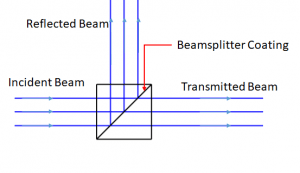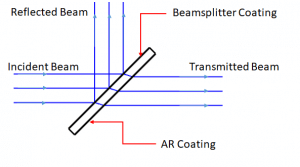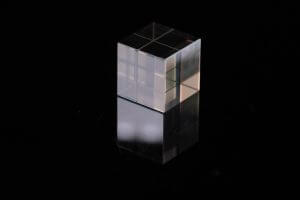A beam splitter (or beamsplitter) is an optical component used to split incident light into two separate beams, typically based on wavelength or polarity. This precise ability to split light by wavelength makes beam splitters essential in various fields, including laser systems, semiconductor technologies, and photonics instrumentation. Additionally, beam splitters can function in reverse to combine two beams into one.
Shanghai Optics manufactures a wide range of high-quality beamsplitters optimized for different applications. Our selection includes plate and cube designs, offering polarizing, non-polarizing, and dichroic options. All our custom beam splitters are made from premium glass, ensuring superior surface quality and tight tolerance on all optical parameters.
Cubic beam splitters usually consist of two right-angle prisms carefully cemented together with optical glue. The thickness of the optical glue depends on the wavelength of light for the intended application. One inner surface of one of the prisms is coated with a partially reflective metal di-electric coating.
The cube should always be oriented so that incident light enters the coated prism to minimize energy passing through the optical cement. Entering from the wrong side will cause more than triple the amount of energy to pass through the delicate cement layer, which may degrade over time if exposed to high-power light sources. We place a reference mark on the ground side of the coated prism to ensure proper orientation.
These cube beam splitters have no beam shift and can be easily integrated with 0-degree angle of incidence. The reflected and transmitted optical path lengths are equal, and compared to other options, they allow you to shorten the optical path of a system. Their only disadvantages are the heavy construction—each piece is solid glass—and the fact that they are both difficult and expensive to manufacture in large sizes. We recommend these beam splitters in situations where simplified mounting and durability are critical.
Cube beamsplitter diagram:

Plate beam splitters, on the other hand, are lighter, less expensive, and can be easily manufactured in any size. They consist of a flat, thin glass plate with a coating on the first surface of the substrate. This coating splits the incident beam by a specified ratio. The reflected and transmitted optical paths have different lengths, and there is a beam shift in transmitted light. Although these optics are often designed for a-45 degree angle of incidence, setup may require extra alignment time. Plate beam splitters are cheaper to manufacture than cube beam splitters.
Plate beamsplitter diagram:


Beamsplitter Glass
A dichroic beam splitter, or dichroic mirror, is an optical filter that transmits selected wavelengths while reflecting others. These beam splitters are typically used at non-normal angles of incidence. If placed at a 45-degree orientation to the incident light, the reflected light will be at a 90-degree angle. When selecting the ideal dichroic beam splitter for your application, consider the following:
Our dichroic beamsplitters feature very steep edges, and our narrow spectral band edge tolerances ensure maximum spectral stability.
As the name suggests, these optics divide a light beam into two separate beams, splitting light according to its polarity. They are often used to transmit p-polarized light while reflecting all s-polarized light in a different direction. The polarizing beam splitters we manufacture at our factory include cubic beamsplitters, plate beamsplitters, and lateral displacement beamsplitters.
A non-polarizing beam splitter is used to split light independently of the polarization state. These filters have very small polarity dependences (typically about 3-6%). Our non-polarizing beam splitters are used in laser beam manipulation and interferometry, and we offer both plate and cubic options. These dichroic mirrors can be customized with a metallic coating for partial reflection for the wavelength of your chosen wavelength.
If an incident beam needs to be divided into two displaced parallel beams, a lateral displacement beam splitter is ideal. Our precision lateral displacement beam splitters, consisting of a rhomboid prism cemented to a right-angle prism, ensure that the exiting beams have no more than 30 arcseconds of deviation from parallel. A multi-layer anti-reflection coating on both entrance and exit faces provides increased efficiency.
Laser beam splitters separate a laser beam into two sections and are typically designed to reflect part of the beam, either differentiated by wavelength or polarization. For laser applications, cubic, plate, or lateral displacement beam splitters are all possible options, and each can be custom-made for laser wavelengths. Surface quality is essential for any laser optics, and our state-of-the-art machinery and strict quality control ensure that every optic leaving our factory meets all applicable standards.
Laser beam combiners are optical devices designed to merge two or more laser beams into a single, unified beam. This is achieved by selectively combining beams based on their wavelength or polarization. These devices are commonly used in applications requiring multiple laser sources to be integrated into a single output, such as in scientific research, telecommunications, and high-precision manufacturing. By effectively merging laser beams, these combiners help optimize space and enhance system performance.
Pellicle beam splitters are ultra-thin optical components designed to split incident light into two separate beams without significant beam displacement or optical path length changes. Made from a thin membrane stretched over a frame, pellicle beam splitters are ideal for high-precision applications where minimal optical distortion and interference are critical. Their thin profile reduces the potential for ghost reflections and beam shifts, making them well-suited for applications like interferometry, microscopy, and high-speed imaging. However, due to their delicate structure, they are typically used in low-power laser systems to avoid damage. Pellicle beam splitters are valued for their ability to split light while maintaining alignment accuracy and image quality.
Please contact us to discuss beam splitter designs or custom orders. Our team is experienced in optical design and can help you determine the ideal beam splitter for your situation. We can assist you from blueprint to prototype to full-scale production of your optical product. Custom beam splitters tailored to your specific wavelength ranges and tolerance levels are also available upon request.